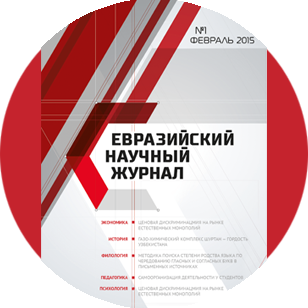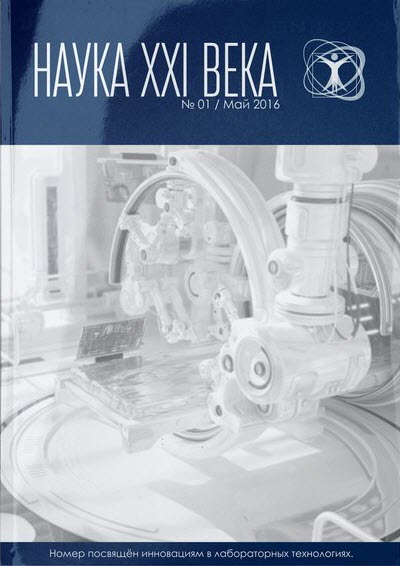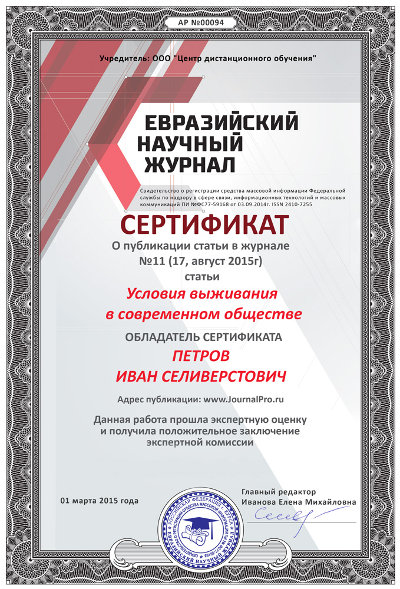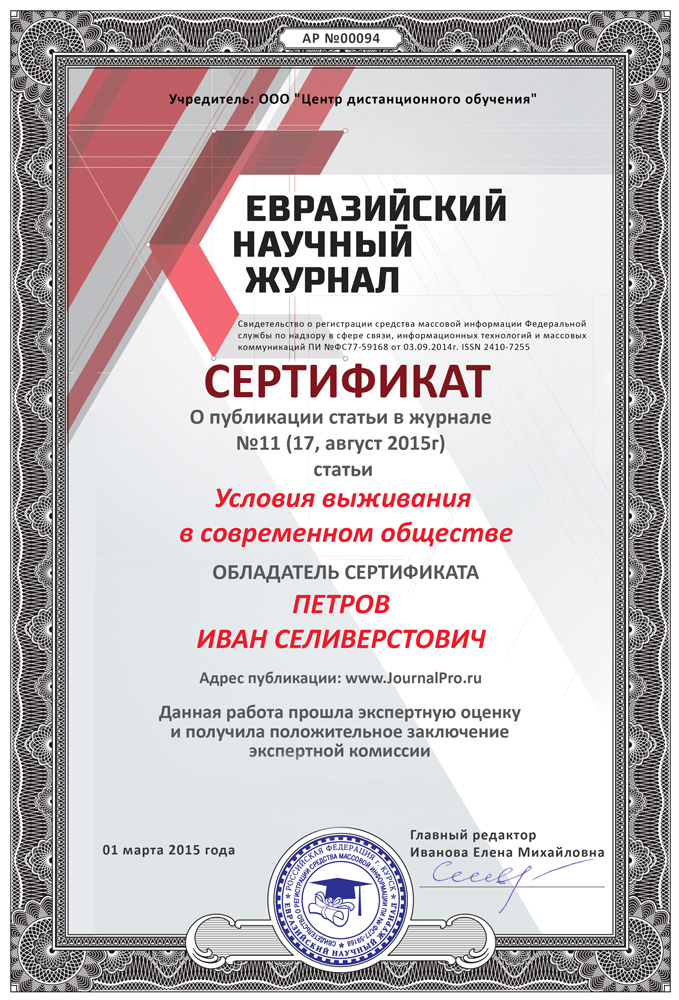Срочная публикация научной статьи
+7 995 770 98 40
+7 995 202 54 42
info@journalpro.ru
Alternative view on the development of law, or Can the law develops without the help of people?
Рубрика: Юридические науки
Журнал: «Евразийский Научный Журнал №4 2019» (апрель, 2019)
Количество просмотров статьи: 1743
Показать PDF версию Alternative view on the development of law, or Can the law develops without the help of people?
Ильин Вадим Павлович
Студент 2-ого курса
института Частного права, МГЮА,
Россия, г. Москва
E-mail: teasoley.y1andex.ru@yandex.ru
Problems of the emergence of law, its formation, development and change have been worrying humanity for many centuries. At the past it seemed to be quite logically, that since law was created by the people themselves, it can develop only with their direct will and control. However, with the development of modern technology we can argue with this statement.
First of all, we need to understand the meaning of the word “development”. “Development” is a forward movement, evolution, transition from one state to another. [1] That is “development” usually is change of state from less satisfactory to more. [2] The question we are interested in sounds like this: “Can law independently, without any influence of society, nation or an individual, move from a less perfect state to a more perfect?”
We will not go into the problem of the essence of law, since this is an extremely broad topic and still open for discussion. However, it is worth noting that most scientists around the world agree that law cannot exist without people, because law is something that helps regulate relations between people. Therefore, the development of law is possible only under the influence of human needs, since this is the most important and, quite possibly, the only motive for this development. Does it mean that law can be improved only with the direct will of the people?
With the development of modern technology a huge number of inventions have appeared. One of such inventions is robots. The robot is a kind of machine, that performs actions similar to human actions. [3] Similar robots, analyzing the works of artists, poets, composers, are able to create new works on the basis of this artwork. One such example was considered at the forum “Open innovations”: two programmers from the company “Yandex” “trained” artificial neural network (similarity to human nerve cells) [4] to copy the style of Egor Letov (poet, musician) [5]. Then the programmers programmed the network to write new poems, which were called “Neural defense.” A few days later, random passersby on the street were shown Letov’s poems and neural network’s poems and were proposed to determine which of them was written by man, and which by computer. More than sixty percent of people could not give the right answer [6].
To sum up, despite the fact that artificial intelligence is not capable of creating something radically new, it can, analyzing the existing works, produce something, that was not in the world. In the example above you can see, that the computer wrote the artwork with rhyme, tact and meaning so that people could not distinguish these poems from works written by man.
Therefore, the question arises: is it possible to recognize a new creation as a work of art? And who should be declared as the author of this work? Is it the person who created the neural network or the neural network itself?
Now at various levels of authority begins to discuss the possibility of granting robots certain rights. On 31 may 2016, the European Parliament Committee on Legal Affairs published a report on the website of the European Parliament [7]. Its essence was to create a registry of intelligent autonomous robots, behind each of which will be assigned certain rights and obligations. According to the authors of this document, increase of logic functions and autonomy of robots require revision of a range of related areas — from taxation to legal liability. From this initiative there is a tendency to rethink the position of robots in the society. If the most “smart” machines are given some rights and obligations, why can’t they be given, for example, the copyright to works of art? Opponents of this believe that the robot does not actually create anything new, acting only by analogy with the program introduced into it. However, the person who copied the style of any famous poet is considered the author of his work.
In October 2018, an unprecedented event occurred. At the auction “Christie’s” in New York for $432,500 painting, created by the neural network, was sold. The amount of the sale exceeded the expectations of experts by 45 times. And the most interesting thing is that in the corner of the picture, where artists usually leave their initials or signature, there is a mathematical formula that was laid in the basis of the neural network. [8] Undoubtedly, this event will be included in the annals of the history. However, now it poses a huge number of questions: if there are precedents for the recognition of the authorship of artificial intelligence, then, of course, this issue must be clearly and quickly resolved. But in most legal systems of the world neither robots nor neural networks are subjects of law. Consequently, we can talk about the need to revise many provisions of the current legislation under the influence of global trends. If robots at the legislative level are granted copyright to works, we can talk not only about works in the field of art. For example, neural networks such as those described above, dealing exclusively with legal issues, can be created. Their activities may cover the following points; systematization of law, analysis of the effectiveness of all normative legal acts on the basis of legal practice, the selection of the most effective laws, their progressive adjustment, and finally, on the basis of all the above, the development of new, most effective rules.
If robots get copyright on works of art, that new legal norms can also be recognized as the creation of machines. Everything created by computer will be developed only in accordance with the needs of people, but people themselves will not play any role in this development. In this case, people will only observe how the right is improved “for the benefit of the people, but without the people.”
The possible consequences of the creation of legal norms by artificial intelligence can be discussed for a long time. There will be both supporters of this path, and opponents. The author of this article believes that all the achievement of humanity should serve him for the benefit. It is necessary to unlock the potential of the use of artificial intelligence in matters related to law. There is a possibility that in the near future the prerequisites for the development of law without the help of people will be formed. Is not it amazing?
References
- Encyclopedic dictionary // dic.academic. URL: https://dic.academic.ru/dic.nsf/enc_philosophy/1013/%D0%A0%D0%90%D0%97%D0 %92%D0%98%D0%A2%D0%98%D0%95 (date of recourse: 16.02.2019).
- Explanatory dictionary of Yefremova // www.efremova.info. URL: https://www.efremova.info/word/razvitie.html#.XGfl0egzZPY (date of recourse: 16.02.2019).
- Dictionary of Ozhegov // http://www.ozhegov.com. URL: http://www.ozhegov.com/words/30783.shtml (date of recourse: 16.02.2019).
- Artificial neural network // Bauman National Library URL: https://ru.bmstu.wiki/%D0%98%D1%81%D0%BA%D1%83%D1%81%D1%81 %D1%82%D0%B2%D0%B5%D0%BD%D0%BD%D0%B0%D1%8F _%D0%BD%D0%B5%D0%B9%D1%80%D0%BE%D0%BD%D0%BD%D0 %B0%D1%8F_%D1%81%D0%B5%D1%82%D1%8C (date of recourse: 16.02.2019).
- Egor Letov // 24СМИ. URL: https://24smi.org/celebrity/4458-egor-letov.html (date of recourse: 16.02.2019).
- “Neural defense”: the robot wrote lyrics “based on the works of Egor Letov” / / Medusa. URL: https://meduza.io/shapito/2016/06/28/neyronnaya-oborona-robot-napisal-teksty-pesen-pod-egora-letova (date of recourse: 16.02.2019).
- DRAFT REPORT // http://www.europarl.europa.eu. URL: http://www.europarl.europa.eu/sides/getDoc.do?pubRef=-//EP//NONSGML+COMPARL+PE-582.443+01+DOC+PDF+V0//EN (date of recourse: 16.02.2019).
- The painting, created by artificial intelligence, sold at auction for $432 500 // www.kp.ru. URL: https://www.kp.ru/daily/26900.7/3944868/ (date of recourse: 9.03.2019).









